Sven1977 Member Username: Sven1977 Post Number: 55 Registered: 04-2004 Posted From: 209.220.229.254 |
Here's a building that needs identifying. It's the Detroit Machinery Center near the Lynch Road plant and close to Conant. Any thoughts? 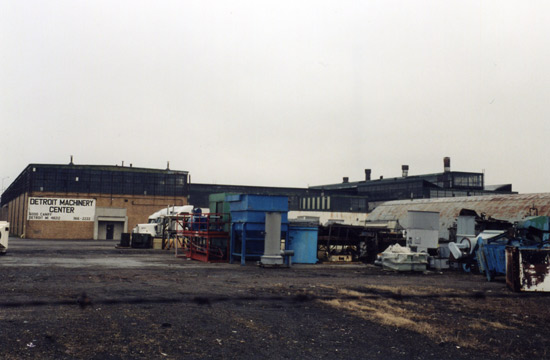 Two buildings off of Jefferson or Fort near Clark taken about four years ago. 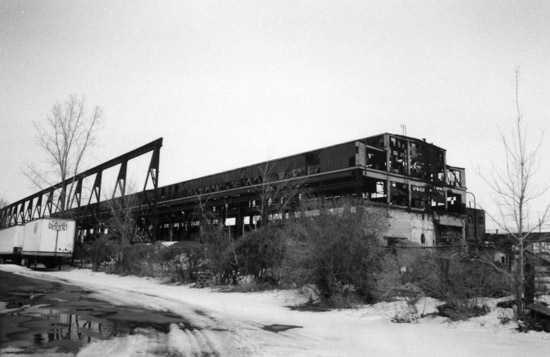 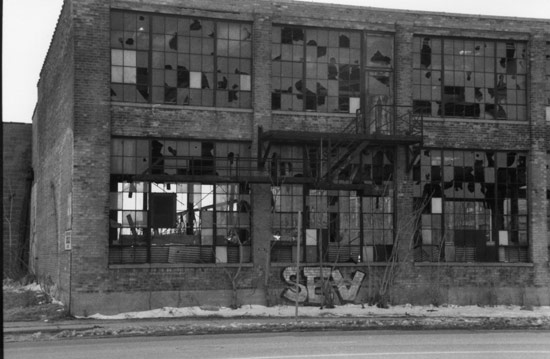 | ||||||||||||||||||||||||
Jjaba Member Username: Jjaba Post Number: 1616 Registered: 11-2003 Posted From: 24.22.6.155 |
Here is some info. about Malcolm Little, AKA Malcolm X. Malcolm came to live with his brother Wilfred Little in Inkster, Mich.in Aug. 1952. His first job was as a furniture salesman in a store in "the black ghetto." Presuming where, is only a guess. For a very short time in Jan. 1953, Malcolm took a job as a grinder making "almost white wages" at the new Ford Plant, Wayne, Michigan. A grinder was a worker on the assembly line who smoothed out metal after welding. It was a hot, nasty, dirty job. He worked on Lincoln, Mercury and Ford cars. In Feb. 1953, Malcolm is working at Gar Wood Industries in Detroit again grinding, but this time they were truck bodies. He also pushed them around alot. He pushed around truck frames also. Gar Wood had several plants which produced garbage truck bodies and the famous boat yards. Malcolm reports that at each plant, he learned to find East, and was able to take breaks to pray. Near the end of 1953, Malcolm left Detroit for Philadelphia to preach in a Mosque. While in Detroit, Malcolm was involved in the Linwood Ave. Mosque of the Nation of Islam, Black Muslims. jjaba, Saalam Brother Malcolm | ||||||||||||||||||||||||
Kathleen Member Username: Kathleen Post Number: 418 Registered: 10-2003 Posted From: 140.244.107.151 |
Following up MikeM's posting about Dr. Charles K. Hyde's article on Dodge Main.... The Detroit News just announced its Spring 2005 Book & Author Luncheon lineup which includes Dr. Charles K. Hyde for his forthcoming Wayne State University Press book entitled "The Dodge Brothers: The Men, the Motor Cars, and the Legacy." This book is touted as "the first scholarly study of the Dodge brothers and their company, chronicling their lives and examining their influence on automotive manufacturing and marketing trends in the early part of the twentieth century." For details: http://wsupress.wayne.edu/glb/ detroit/hydedb.htm Further, in digging around the Web for more info on the book, I came across this June 5, 2002 Detroit News Letter to the Editor by Dr. Hyde about the Boydell Building's future and since I can't recall mention of the Boydell among all the car factory buildings discussed in this thread: Greektown: Preserve historic Boydell Bldg. I read The News recent article on the Greektown Casino's plans for its permanent casino with much interest, but also with some concern ("Greektown maps $375 million expansion," May 24). As an historian of the Detroit automobile industry and a preservationist interested in conserving auto heritage sites, I am troubled by the plans to demolish the Boydell Building on Beaubien for casino expansion. The Boydell Building has great significance in the early years of the automobile industry. David Buick manufactured engines there in 1899-1900 for the first Buick car and the Dodge brothers (John and Horace) began their auto industry careers making engines and transmissions for Oldsmobile in the same building in 1901-1902. The Dodge brothers went on to supply Henry Ford with more than half of his automobile parts in 1903-1914 before launching their own nameplate. With the demolition of the Dodge Main plant in 1981, the Boydell Building is the only surviving Detroit factory associated with the Dodge brothers. I would urge the owners of the Greektown Casino to consider saving the building and incorporating it into the design of their new permanent casino. It would be a shame to see yet another part of Detroit's automotive heritage fall to the wrecking ball. Dr. Charles K. Hyde Royal Oak http://www.detnews.com/2002/ed itorial/0206/05/a12-506433.htm | ||||||||||||||||||||||||
Aiw Member Username: Aiw Post Number: 3672 Registered: 10-2003 Posted From: 67.71.67.162 |
Here's the Boydell: 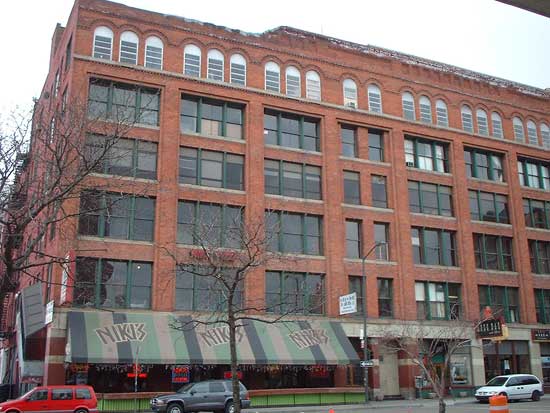 | ||||||||||||||||||||||||
Kathleen Member Username: Kathleen Post Number: 420 Registered: 10-2003 Posted From: 140.244.107.151 |
Thanks, AIW. Just making sure we're covering it all in this thread!!! Would love to have seen the David Buick historic marker here instead of on Atwater. Maybe there should be a marker here covering all the auto pioneers in the Boydell Building or Greektown area!! While we're on the subject of the auto industry in the area of today's Greektown, I would love to know if anyone has knowledge or documentation of the Dodge Brothers garage located on Monroe between Hastings St. and St. Antoine. My grandfather (b. 1891)lived around the corner on Hastings St. and, as a young boy, spent some time in their garage, probably pestering them. Since Old St. Mary's Church and Rectory were built in the mid-1880s, I can surmise that the Dodge Brothers garage was located along the northern edge of today's Annunciation Church's property or across the street where the parking garage stands. Back to Burton and the city directories for more research!! | ||||||||||||||||||||||||
Sven1977 Member Username: Sven1977 Post Number: 58 Registered: 04-2004 Posted From: 209.220.229.254 |
Back to the library for me on Saturday. I'm glad it rained all afternoon. (YOU: What? It was sunny. ME: Shutup!) I found tons of new information on the Sanborn maps dating from 1910 to 1921. Way to much to post in one night. I took 81 pictures from the books. Halfway through, I realized that I was going to run out of memory if I didn't decrease the quality. I got through all seven books and then ran out. I can tell the difference. Sorry about that. I'll go back sometime and shoot higher quality for the really important factories. I'll start off today with long-forgotten cars. 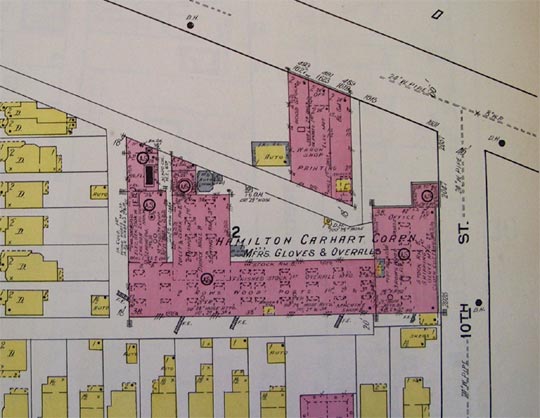 The first Carhartt factory in 1910. Michigan Ave. & 10th St. Ty Cobb used to work across the street. When this was drawn, Mr. Carhartt hadn't been drawn into the world of auto manufacturing. 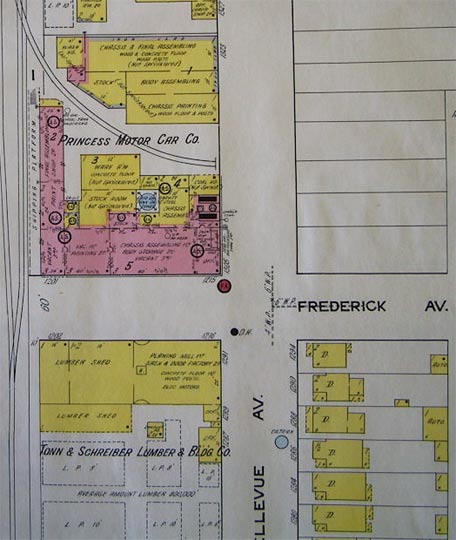 The palace of the Princess at 1201-1215 Frederick & Bellevue. 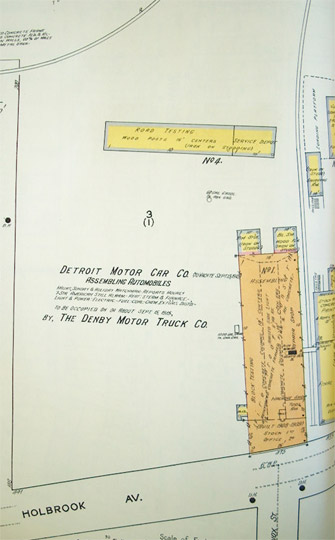 The Detroit Motor Car Company made the "Detroiter" at 1915-1917 Holbrook & Greeley. 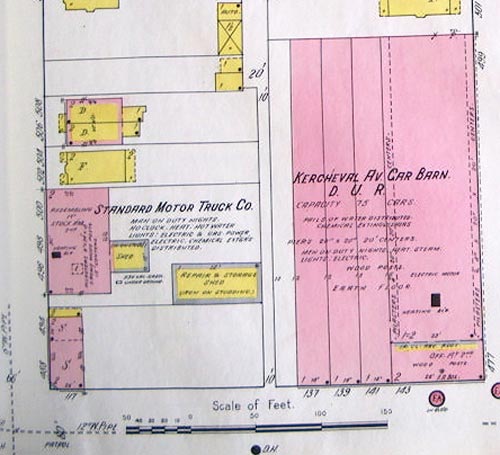 Standard Motor Truck 496-500 Bellevue & Kercheval. 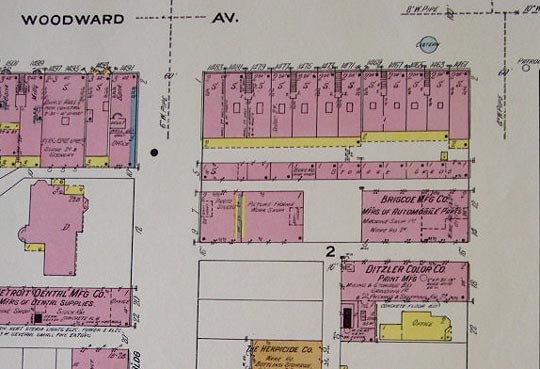 Briscoe at Woodward & Baltimore. A "Maker of Automobile Parts." By 1910, Benny Briscoe was already a big name. Maybe this was just a small building from earlier days. 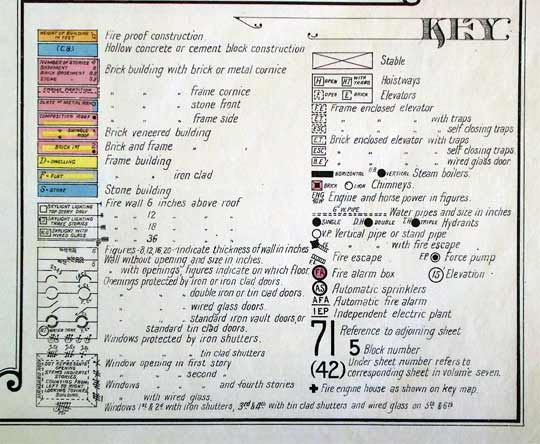 The Key to it all. More to come later. | ||||||||||||||||||||||||
623kraw Member Username: 623kraw Post Number: 588 Registered: 10-2003 Posted From: 68.41.224.200 |
I had this in the archives called FleetwoodPlant1.jpg - Any ideas? Clark St. maybe? 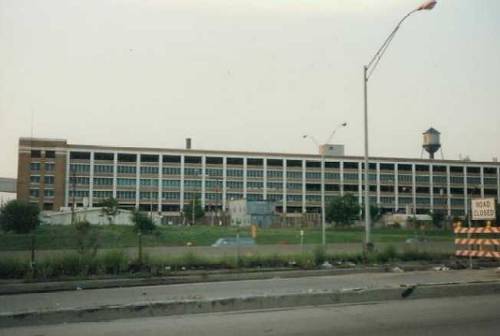 | ||||||||||||||||||||||||
623kraw Member Username: 623kraw Post Number: 589 Registered: 10-2003 Posted From: 68.41.224.200 |
Geo C. Wetherbee ? Any clues? It's on E. Grand Blvd. 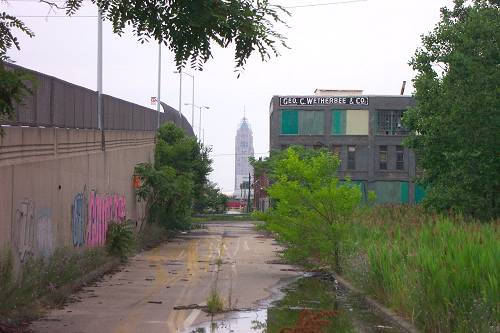 | ||||||||||||||||||||||||
623kraw Member Username: 623kraw Post Number: 590 Registered: 10-2003 Posted From: 68.41.224.200 |
Another postcard: 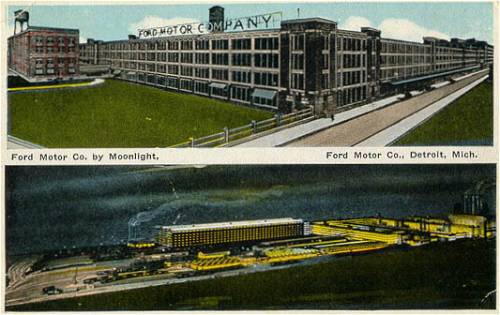 | ||||||||||||||||||||||||
623kraw Member Username: 623kraw Post Number: 591 Registered: 10-2003 Posted From: 68.41.224.200 |
Dodge Main Leftovers 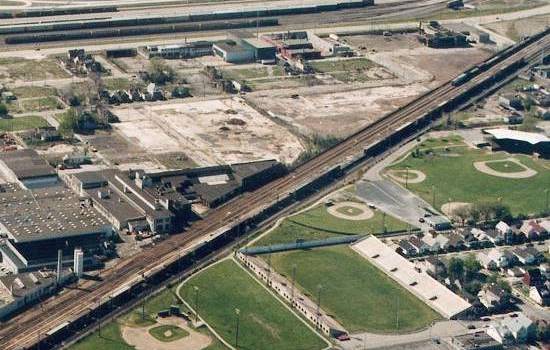 | ||||||||||||||||||||||||
Livernoisyard Member Username: Livernoisyard Post Number: 3 Registered: 10-2004 Posted From: 69.242.223.42 |
My next-door neighbor mentioned last week that he worked at the Fleetwood plant. I thought he said that it was south of Fort by Springwells. And again, it could have been another plant there because he also worked at another plant, probably the Fisher body plant near Clark St, so your guess could be right... | ||||||||||||||||||||||||
Jjaba Member Username: Jjaba Post Number: 1622 Registered: 11-2003 Posted From: 24.22.6.155 |
Excellent post cards. The Ford by Moonlight is obviously Ford Highland Park, Home of the Motel T and the famous movies of his first assembly lines. 15050 Woodward Ave. Highland Park, Mich. (AKA Detroit 3, Michigan) Albert Kahn design, 1909-20. He moved there from Piquette. Back East from Woodward's Office bldg., the plant used the entire 180 acres. jjaba | ||||||||||||||||||||||||
Sven1977 Member Username: Sven1977 Post Number: 59 Registered: 04-2004 Posted From: 209.220.229.254 |
More trivial car companies and their layout from the Sanborn Maps. The Warren Motor Car Company. 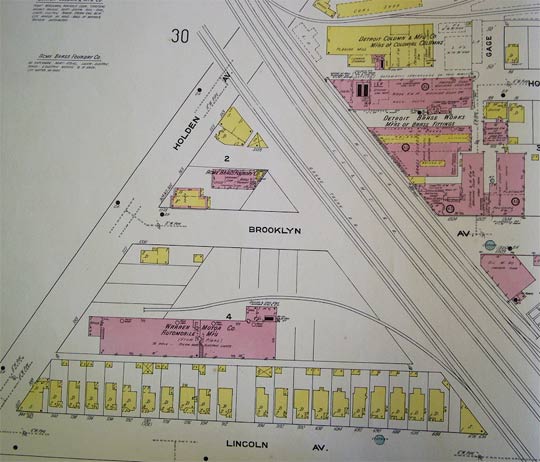 The home of the "Warren-Detroit 30." Photo from "How Detroit Became the Automotive Capital" by R. Szudarek. 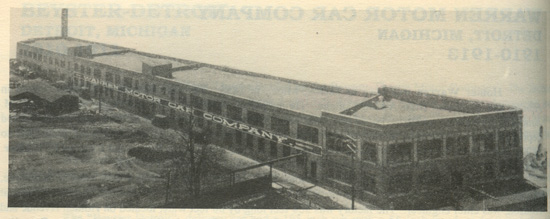 The former Kritt factory on EGB. By 1915 or 1921 it was being used by Packard. 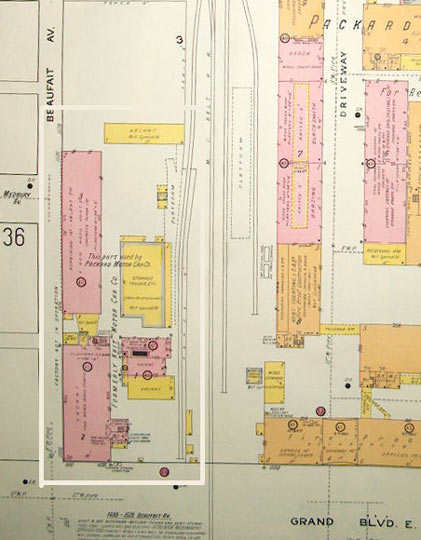 The photo below is borrowed from "How Detroit Became the Automotive Capital." The cation in the book says the factory was at EGB and Mt. Elliot. This building is at EGB and Beaufait. 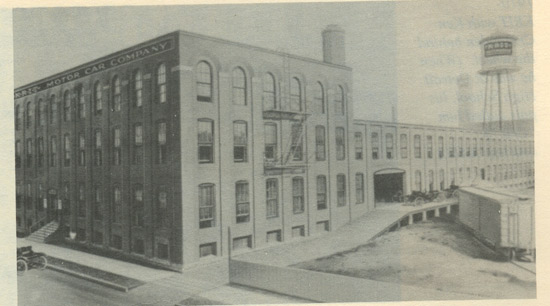 | ||||||||||||||||||||||||
Jenkje Member Username: Jenkje Post Number: 94 Registered: 04-2004 Posted From: 69.212.255.133 |
Geo C. Wetherbee was a hardware distributor from what I heard the 50's all the way to the mid-90's. They would supply certain lines to Damman Hardware, Tractor Supply Company and other various small independant hardware stores (ie. Busy Bee Hardware). They went out of business around 98-99. I worked two summers there in their crappy ass warehouse for $5.25 / hour. That place was a dump because the company made little or no money for the longest time. There were wooden floors and the entire third floor was abandoned due to holes in the floor, holes in the roof and various animals living there. Cars would get stolen out of the parking lot under the Grand Blvd bridge and people used to sleep under that bridge. The guy who owned the company was a moron named Al Zimmerman who was more concerned in trying to nail the secretaries than his business that his father built. | ||||||||||||||||||||||||
Jjaba Member Username: Jjaba Post Number: 1624 Registered: 11-2003 Posted From: 192.220.139.18 |
Jenkje, that's a colorful story. Imagine one generation ago, jjaba earning 60 cents an hour as a Wrigley's stock boy. Wages went to 80 cents when he was promoted to cashier. Sorry for the threadjacking. Won't happen again. jjaba | ||||||||||||||||||||||||
Sven1977 Member Username: Sven1977 Post Number: 60 Registered: 04-2004 Posted From: 209.220.229.254 |
Today's Sanborn map are of Cadillac facilities dating from 1910 to 1921. First, the Amsterdam grouping. 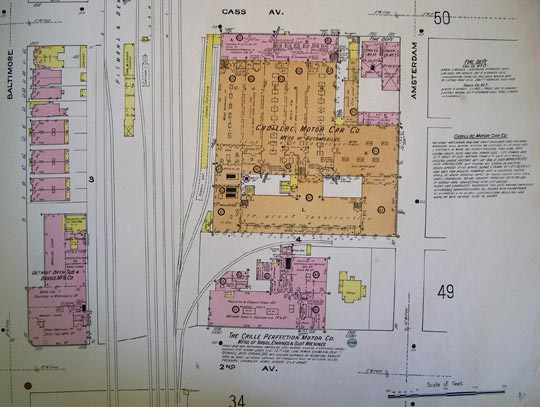 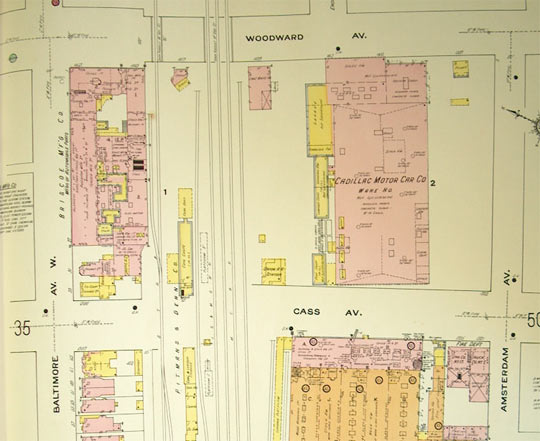 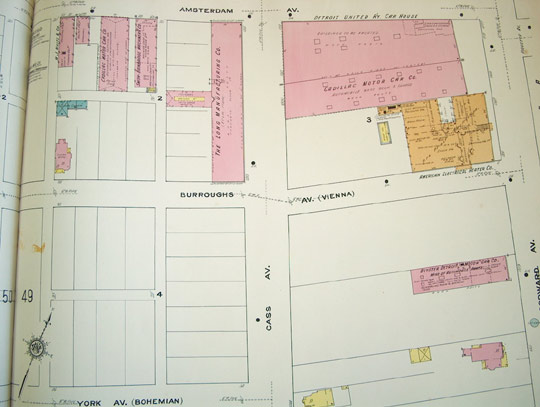 Note the Briscoe plant on Woodward. The shots below was taken at the end of March, 2005. 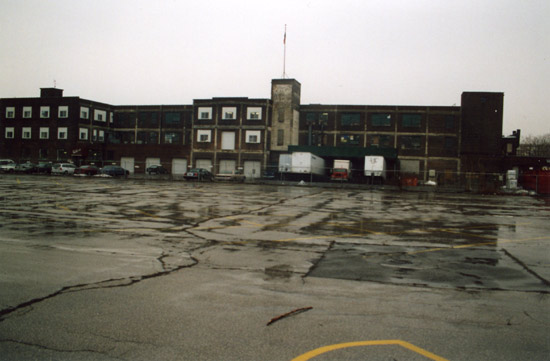 The two maps below are of the Cadillac facilities near Fort Street and 23rd. 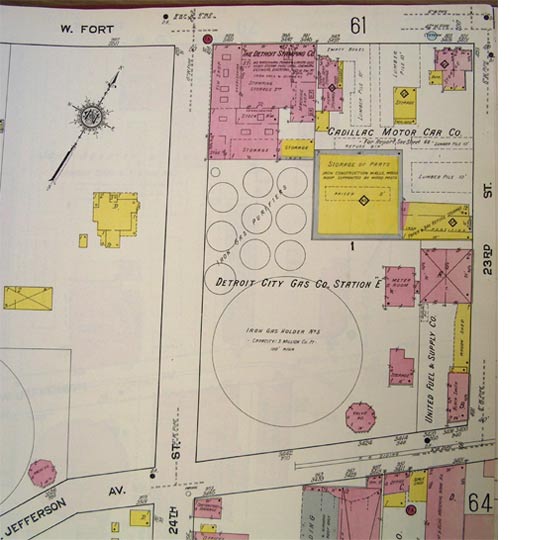 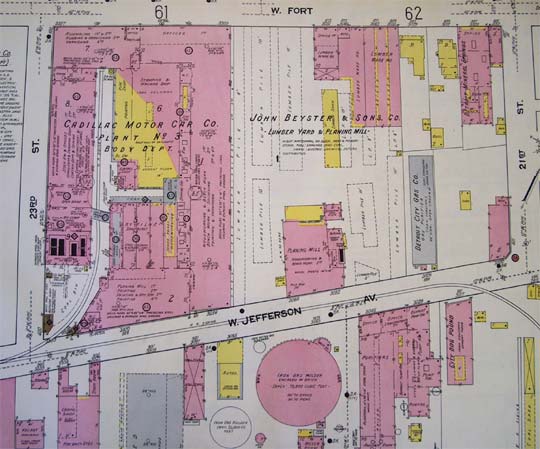 | ||||||||||||||||||||||||
Sven1977 Member Username: Sven1977 Post Number: 61 Registered: 04-2004 Posted From: 209.220.229.254 |
Jjaba, Here is EGB and DuBois in 1915. I think this is the intersection you asked about. 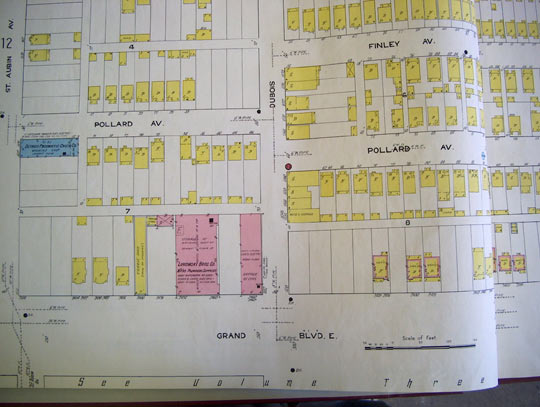 | ||||||||||||||||||||||||
Mikem Member Username: Mikem Post Number: 1365 Registered: 10-2003 Posted From: 68.43.12.165 |
EZ, did you have a hand in the investigative work on this website?: http://aerowarriors.com/afct.h tml Do you know what this building was used for before Habitat for Humanity?: http://aerowarriors.com/jpgs/a fct12.jpg | ||||||||||||||||||||||||
Hamtramck_steve Member Username: Hamtramck_steve Post Number: 2027 Registered: 10-2003 Posted From: 68.41.218.4 |
In an auto-plant related question, does anyone know when the Mt. Elliott connector bridge was built? The bridge connects Mt. Elliott to Mound Road. At one time, it was referred to as the "Hamtramck Bypass," because it was constructed specifically to allow traffic to get around Hamtramck after Mt. Elliott stopped being a through street. | ||||||||||||||||||||||||
623kraw Member Username: 623kraw Post Number: 594 Registered: 10-2003 Posted From: 68.41.224.200 |
Not me, although the name Greg Kwiatkowski does ring a bell - Hamtown historian perhaps? | ||||||||||||||||||||||||
Sven1977 Member Username: Sven1977 Post Number: 62 Registered: 04-2004 Posted From: 209.220.229.254 |
Today's Sanborn maps are of the Anderson Carriage Company which satrted in 1907 and became the Anderson Electric Car Company in 1911 and finally in 1919 it changed its name to the Detroit Electric Car Company. It lasted until 1939. Note how Anderson and C.R. Wilson are kind of intermixed with each other. The maps are from 1915. 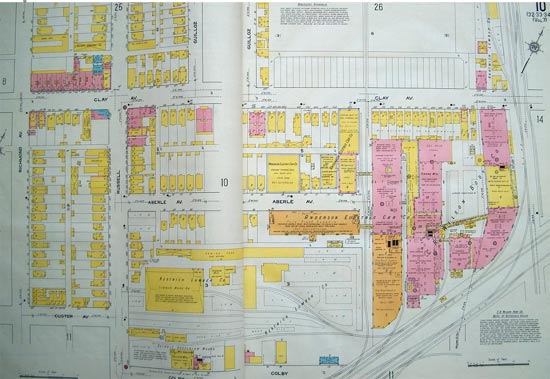 A closer view below. 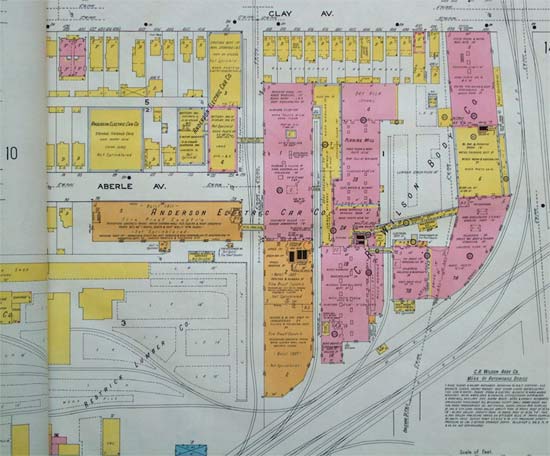 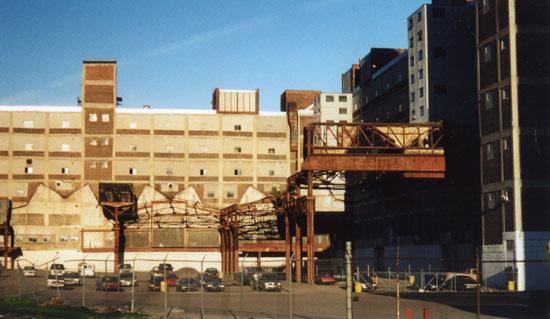 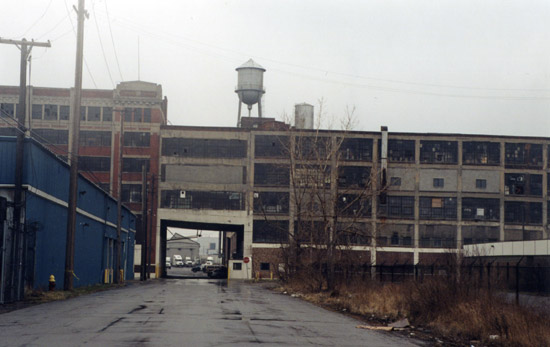 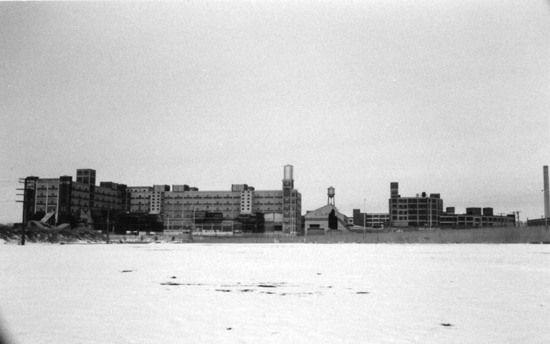 Here are three maps of other factories near Anderson. 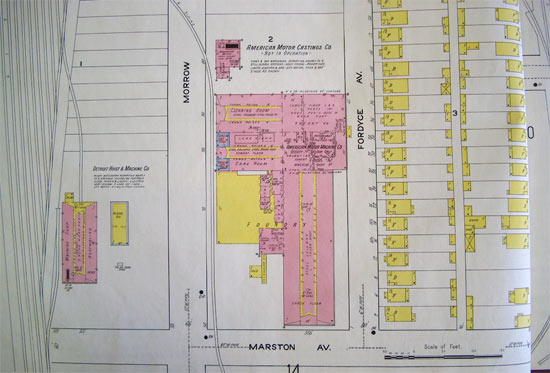 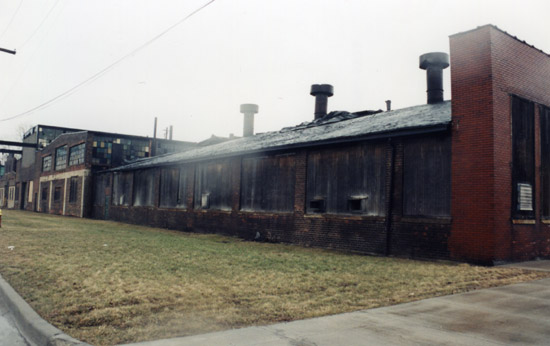 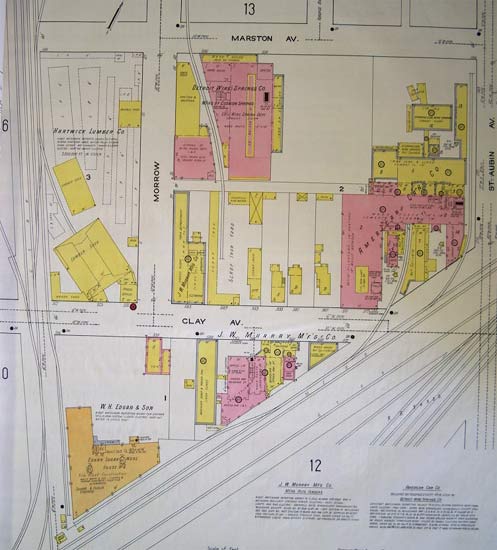 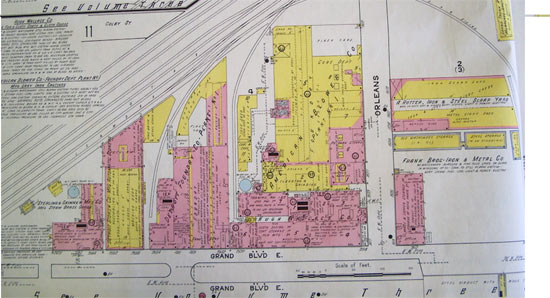 | ||||||||||||||||||||||||
Hamtramck_steve Member Username: Hamtramck_steve Post Number: 2029 Registered: 10-2003 Posted From: 68.41.218.4 |
EZ, you're thinking of Greg Kowalski, the chair of the Hamtramck Historical Commission. | ||||||||||||||||||||||||
Mikem Member Username: Mikem Post Number: 1370 Registered: 10-2003 Posted From: 68.43.12.165 |
Thanks EZ, I get you Hamtramck guys mixed up! Is the Wetherbee building the same one that's been converted into the Milwaukee park Lofts?: https://www.atdetroit.net/forum/messages/36206/39914.html Sven, I can't read the detail on some of those maps -- what is the collection on Morrow, both sides of Marston? Did you ever find out what the first two buildings were that you posted pictures of, at the very beginning of this thread? The Penberthy Injector Co was located across the tracks from the first one, to the north or behind it: 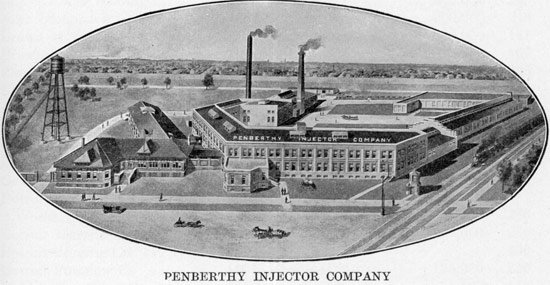 From my 1922 source: "Penberthy was incorporated in 1886 and to manufacture an improved steam injector invented by Wm Penberthy. After a boiler explosion destroyed their factory on Abbott Street, they bought 5½ acres on Greenwood, Holden, and the Grand Trunk RR, and built a new factory. They currently make injectors of different types for boilers, ejectors, valves, lubricating devices, gasoline and oil guages, carburetors, re-atomizers, flowmeters, etc. During the War (WWI), the Penberthy Co manufactured carburetors for tanks and ordinance materials of various kinds, and for this work received a citation from the U.S. Government. A second plant has been opened on Goldsmith Avenue for the manufacture of steel parts." From 1949, you can see most of the plant north of your building in question. Also, the very beginning of land clearing for the Lodge Freeway, as well as the first overpass for the RR tracks has been built. There is no other evidence of construction in any of the 1949 aerials between downtown and Couzens Highway. I guess they started here to give the new center/GM employees a quick exit to the northwestern suburbs. 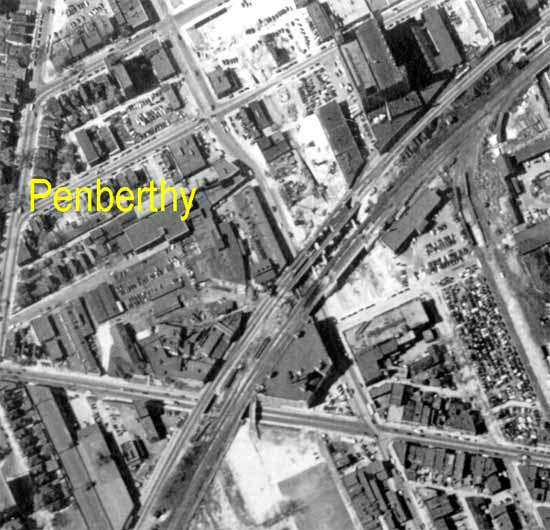 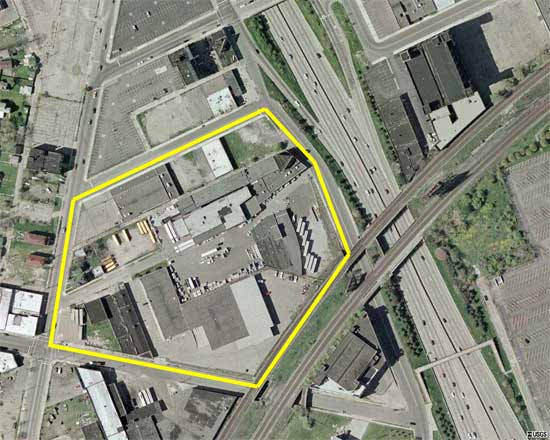 | ||||||||||||||||||||||||
Mikem Member Username: Mikem Post Number: 1371 Registered: 10-2003 Posted From: 68.43.12.165 |
During World War II, automobile production was ceased by government order on February 10th, 1942. (Drastic reductions in production to support the war effort were already scheduled to take effect before America entered the war.) The massive output of Chrysler's war production is well documented in a series of seven books published by Chrysler and written by Wesley Stout. 20,000 tanks (12 models) 438,000 Army trucks 18,000 B-29 engines 60,000 Bofor anti-aircraft artillery guns 3,250,000,000 rounds of small arms munitions 100 miles of submarine nets 1,500 searchlight reflectors 7,800 Sea Mule harbor tugs 29,000 marine engines 328,000 4.5" rockets 101,000 incendiary bombs 1,990,000 20mm shells 2,000 radar antennae & mounts 5,500 Sperry gyro-compasses 20,000 land mine detectors air raid sirens fire pumpers Curtiss Helldiver center wing sections B-26 & B-29 fuselage sections Navy Corsair landing gear Gaseous diffuser equipment for processing A-bomb fuel I covered the history of the Warren arsenal in a previous thread: https://www.atdetroit.net/forum/messages/23585/29358.html However twelve other Chrysler plants contributed to the production of the twelve different models of tanks assembled at the arsenal. Some examples: Dodge Main: 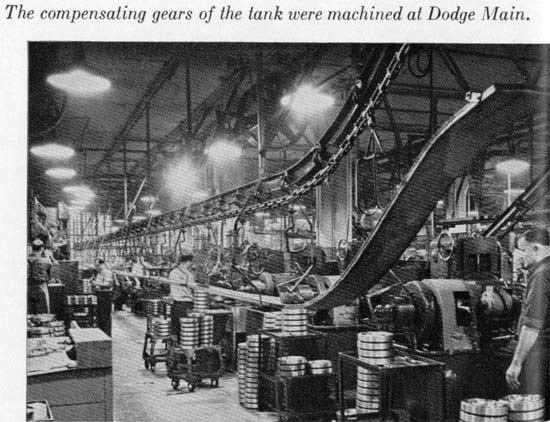 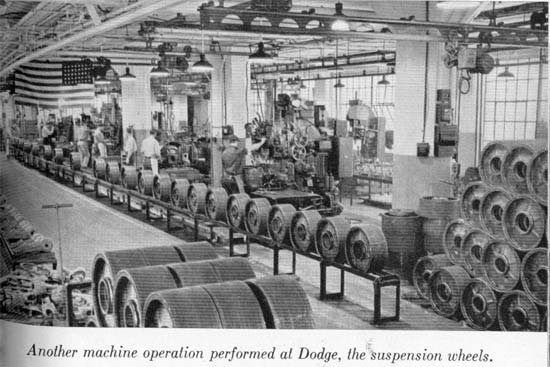 DeSoto: 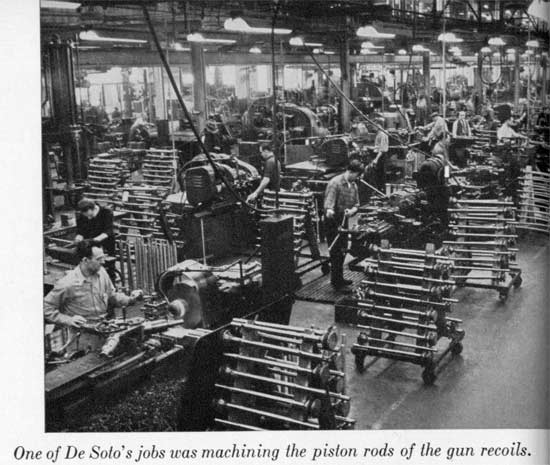 Jeffeson: 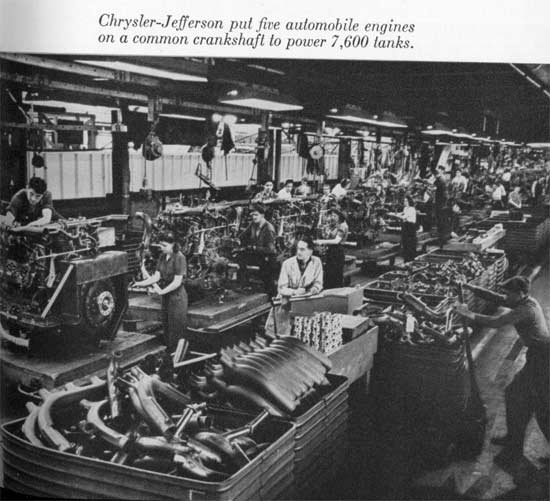 (Development of an engine specifically for the Sherman tank would take too long and the Army had been using aircraft engines for smaller models, but now they were needed badly for aircraft, so Chrysler's solution was "The Egg Beater"; five 6-cylinder motors on a common crankshaft.) Plymouth-Lynch Road: 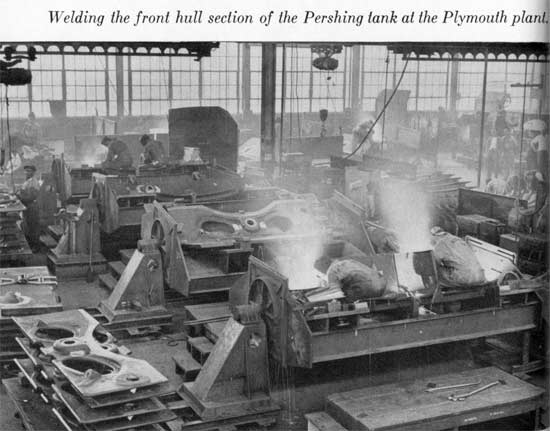 | ||||||||||||||||||||||||
Mikem Member Username: Mikem Post Number: 1372 Registered: 10-2003 Posted From: 68.43.12.165 |
Scientists at MIT's Radiation Lab designed an early radar for directing anti-aircraft artillery, the SCR-584, however the complex mechanical workings of the radar dish mount and its steering gear were left to be worked out by Chrysler engineers. A contract to produce the radar dishes, mounts, and trailers was given to the Dodge Main assembly plant. The trailer job was sub-contracted to Fruehauf. 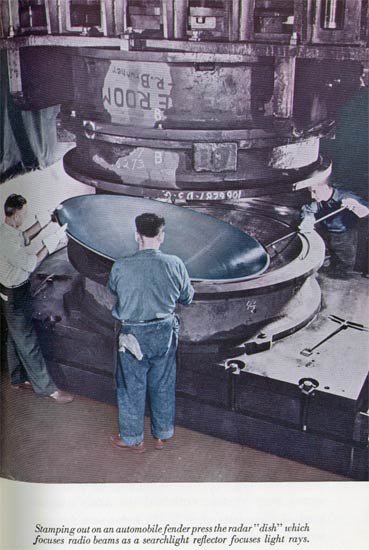 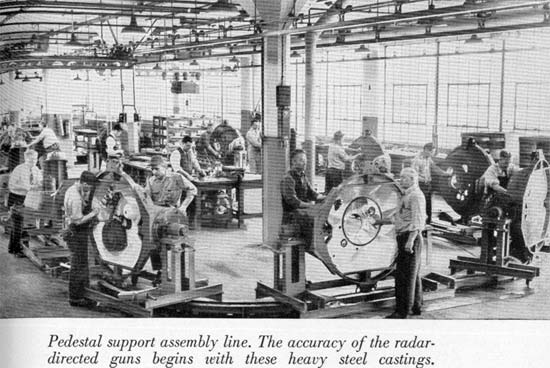 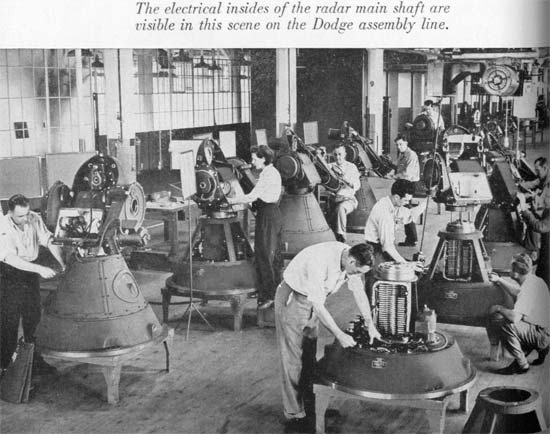 | ||||||||||||||||||||||||
Mikem Member Username: Mikem Post Number: 1373 Registered: 10-2003 Posted From: 68.43.12.165 |
One of the most secret projects Chrysler worked on during the war was the construction of gaseous diffusers for the Oak Ridge Laboratories as part of Manhattan Project. One way of separating the lighter uranium U-235 isotope from the heavier U-238 is by turning uranium into a gas and then filtering it. When uranium is converted into a gas, uranium hexafluoride, it becomes extremely corrosive. Scientist working on the project found that only nickle would resist the corrosiveness of the gas. When Chrysler was contacted for help in building diffusers, Chrysler engineers quickly calculated that the amount of nickel required to build them would use up all of the nickel mined in the country for the last two years. Chrysler tried to convince the scientists that nickel-plated steel would work instead, but the scientist would have none of it; any defect in the plating would allow the gas to corrode through to the steel, destroying the diffuser. Chrysler was more confident in their plating capabilities than the scientists, and a test set up between pure nickel and nickel-plated steel parts showed that nickel-plated steel withstood the gas better than pure nickel. The pure nickel parts had ~1% impurities but these impurities didn't adhere to the steel plate during the electro-plating process resulting in a pure nickel coating. Chrysler went to work on building the diffusers at the Lynch Road plant. All work being done there was moved to other plants, and the factory received air-conditioning for the first time, necessary to keep the plant clean for the plating process.  It took a thousand box cars to ship the nickel-plated steel diffuser parts to Oak Ridge. P.S., Chrysler's part in the project lasted nearly two years and required extreme secrecy, so where did they maintain an office to manage it? In a vacant department store at 1525 Woodward! K. T. Keller, the Chrysler president, drove by the store one day and noticed the empty store which had a war bond office temporarily using the ground floor. He immediately rented the building and used the upper floors for the project's office while the bond drive served as a convenient "front" in the store front. | ||||||||||||||||||||||||
623kraw Member Username: 623kraw Post Number: 595 Registered: 10-2003 Posted From: 68.41.224.200 |
Speaking of Holbrook & Greeley, here's what's there now (the corner of Holbrook & Greeley no longer exists) 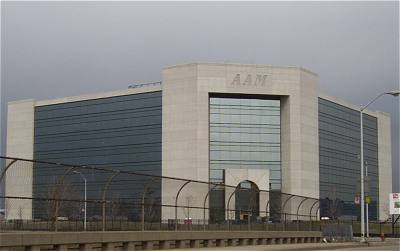 | ||||||||||||||||||||||||
Rustic Member Username: Rustic Post Number: 1445 Registered: 10-2003 Posted From: 130.132.177.245 |
This thread just keeps getting better! mikem's link to the truck fulla Daytonas and SuperB's was one thing but then less then 24 hours later he posts info about the same corp in the WMD business! (A thousand boxcars to Oak Ridge!, Damn, how many trains is that! Incredible!) Detroit is a wonderful, terrible, complicated place! It's history and culture is nothing short of awesome. | ||||||||||||||||||||||||
Sven1977 Member Username: Sven1977 Post Number: 63 Registered: 04-2004 Posted From: 209.220.229.254 |
I never found out what either one of the building are that started this whole thread. Although I just discovered that I've been looking on the wrong side of the train tracks for the big white building on 12th Street. Last time I went out I took a video camera and just reviewed the tape. Here are the Sanborn Maps for the area around Trumbull and Holden. As you can see, I have Pemberthy which totally matches your picture! I believe these maps are from 1910. Sorry that the type is so small. If anyone has a specific question, I can blow up the map to exclude the streets if you want more factory detail. 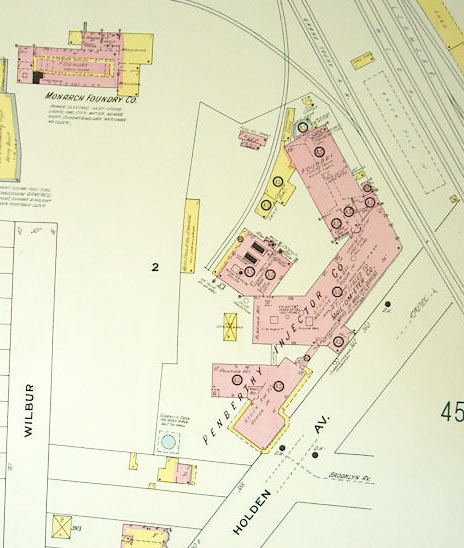 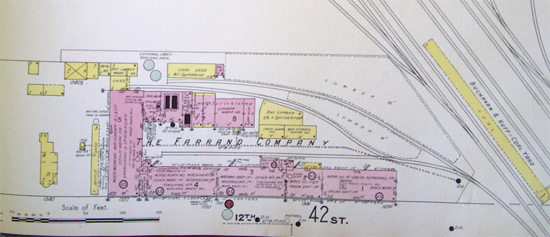 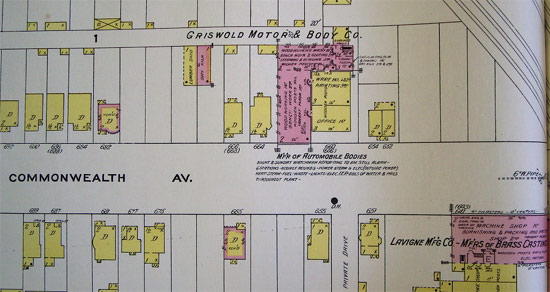 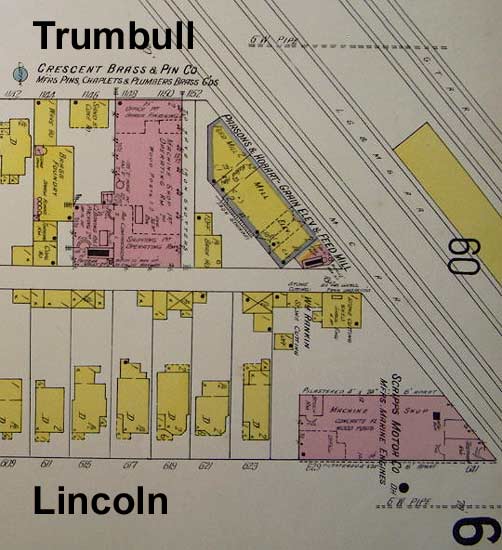 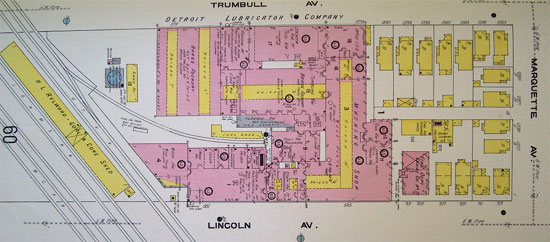 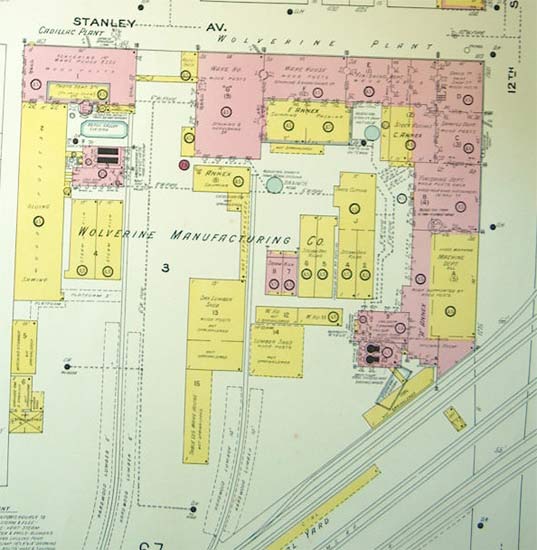 Here are blow ups of the two Morrow/Marston area maps I have. 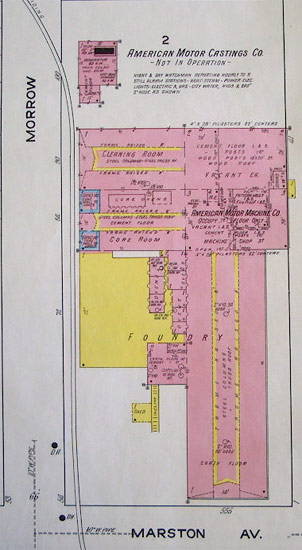 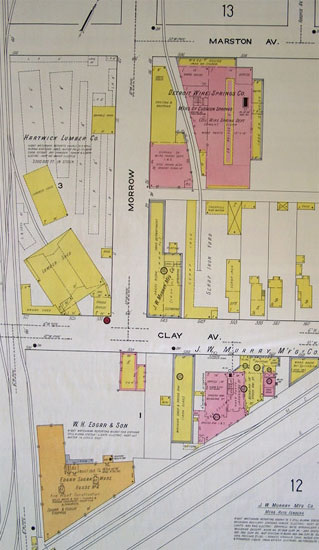 | ||||||||||||||||||||||||
Rustic Member Username: Rustic Post Number: 1446 Registered: 10-2003 Posted From: 130.132.177.245 |
Another thing that comes to mind is Detroit's history of adaptive reuse. Nowadays of course adaptive reuse brings to mind smaller scale stuff ... a neoclassical bank on a corner now a brightly painted party store, or store-front churces or the recent trend of turning commercial into residential in and about the cbd. However, from this thread you can see that adaptive reuse has a long history in Detroit, foundries used as warehouses used as assy plants, assemply plants and even a dept store used as offices, warehouses become assy sites WITHOUT teardown. The ability to rapidly and willingly change on a dime (even in Detroit's BOOM TIMES) is, imo part of Detroit's culture and a unique strength. | ||||||||||||||||||||||||
623kraw Member Username: 623kraw Post Number: 596 Registered: 10-2003 Posted From: 68.41.224.200 |
Here's a shot of Geo C. Wetherbee from the top of the overpass... 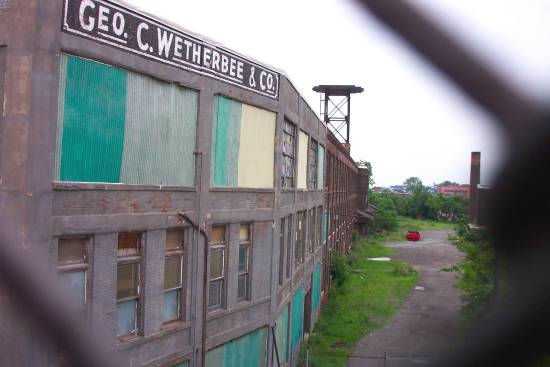 | ||||||||||||||||||||||||
623kraw Member Username: 623kraw Post Number: 597 Registered: 10-2003 Posted From: 68.41.224.200 |
The corner of EGB and Orleans: 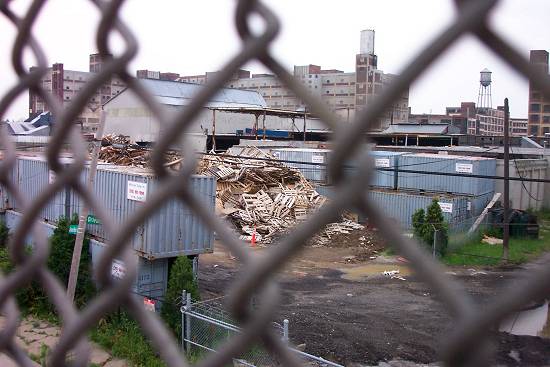 | ||||||||||||||||||||||||
623kraw Member Username: 623kraw Post Number: 598 Registered: 10-2003 Posted From: 68.41.224.200 |
What's south of the overpass? Another factory. Is it on the Sanborn maps? 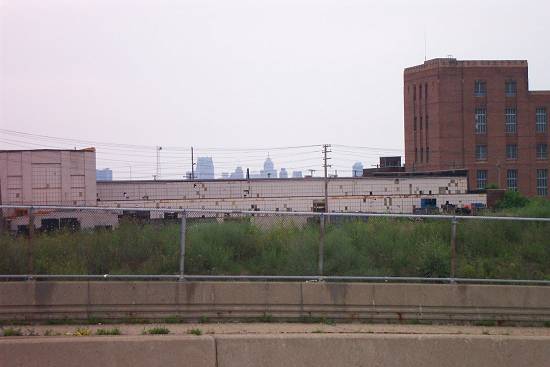 | ||||||||||||||||||||||||
623kraw Member Username: 623kraw Post Number: 599 Registered: 10-2003 Posted From: 68.41.224.200 |
An abandoned hulk south of the EGB overpass: 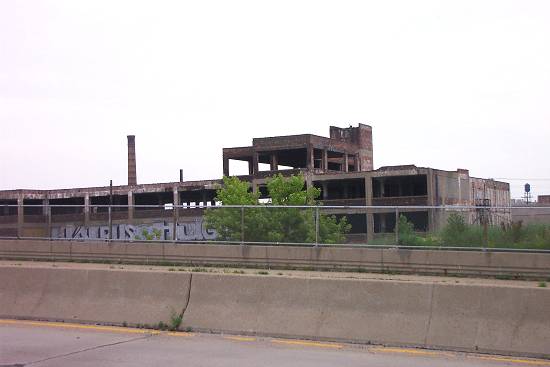 | ||||||||||||||||||||||||
Sven1977 Member Username: Sven1977 Post Number: 64 Registered: 04-2004 Posted From: 209.220.229.254 |
The photo above is looks south of EGB and west of the Dequindre tracks. In 1915-1921, the right-most part of the building used to be the showroom for the Schwanbeck Bros. Box & Showcase Factory. They took up the southeast part of the block with the rest belonging to McCord Mfg. Co. The rest of the building pictured is newer than the Sanborn map I have so I don't know if it changed hands. It is a different building than on the map. I don't know what the middle picture is. | ||||||||||||||||||||||||
Mikem Member Username: Mikem Post Number: 1374 Registered: 10-2003 Posted From: 68.43.12.165 |
The taller brick building to the right, two photos above is Detroit Edison's "Frisbee Substation". A couple of years ago, DTE was taking part in a test of a high temperature super-conductive cable as a means of delivering large amounts of power within the city using underground cables. Underground cables are limited in how much current they can carry due to cooling and insulation requirments so higher voltage transmission lines end up on large steel structures instead. The Italian rubber company Pirelli made the new technology cables for the test but I haven't heard anything about the results since then (~ 2001). | ||||||||||||||||||||||||
Aiw Member Username: Aiw Post Number: 3690 Registered: 10-2003 Posted From: 67.71.66.90 |
Quick question, when was the last renumbering? If I had an address from 1924 on Piquette, would it be the same today? | ||||||||||||||||||||||||
Mikem Member Username: Mikem Post Number: 1375 Registered: 10-2003 Posted From: 68.43.12.165 |
I thought it was 1920. | ||||||||||||||||||||||||
Aiw Member Username: Aiw Post Number: 3692 Registered: 10-2003 Posted From: 67.71.66.90 |
Thanks Mike... I came across reference to a Autobolie Crakshaft Corporation that went out of business in 1924, they were located at 540 Piquette Ave. So if there has been no renumbering since then, that means they would have been located inside Fisher Body # 23... Was GM already done with that plant and sub-leasing space by 1924? 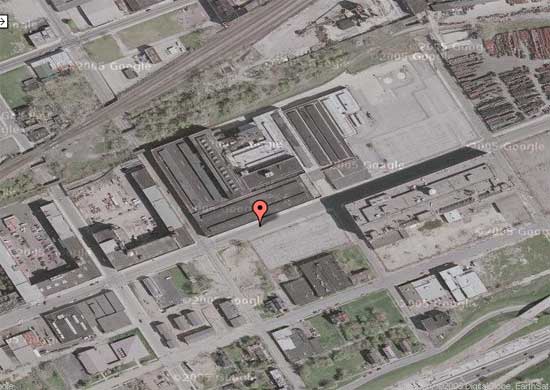 | ||||||||||||||||||||||||
Aiw Member Username: Aiw Post Number: 3693 Registered: 10-2003 Posted From: 67.71.66.90 |
Upon further inspection it appears that 540 was on the shouth side, were the empty lot is... But wasn't that also part of Fisher 23? | ||||||||||||||||||||||||
Sven1977 Member Username: Sven1977 Post Number: 65 Registered: 04-2004 Posted From: 209.220.229.254 |
I'm glad the Sanborn maps are helping out. Right company, right location, wrong address. I hope you can read the number. 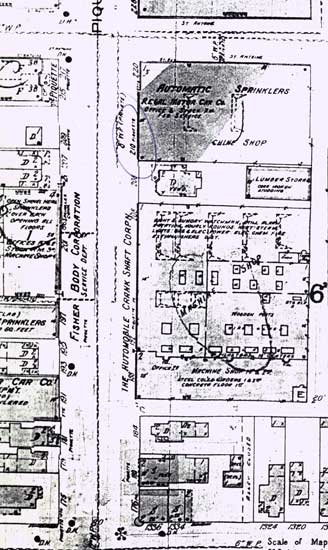 Now that I see it, the numbers are hard to read. From Beaubien to St. Antoine, the addresses go from 188 to 220. | ||||||||||||||||||||||||
Mikem Member Username: Mikem Post Number: 1376 Registered: 10-2003 Posted From: 68.43.12.165 |
Sven, I think your map is pre-1920 when the city addresses were renumbered to make them more rational. AIW, I have the Automobile Crank Shaft Corp, "incorporated September 1916, to suceed the old Automobile Crank Shaft Co of Michigan, which was organized in 1906. The company manufactures crank shafts for motors for autos, marine engines, aeroplanes, and tractors. The plant is located on piquette Avenue." Even numbers are on the right as you move away from downtown, right? I can't remember if we found anything across the street from Fisher 23, although I thought the Sanborns showed it originally being Fisher #3? | ||||||||||||||||||||||||
Mikem Member Username: Mikem Post Number: 1378 Registered: 10-2003 Posted From: 68.43.12.165 |
Another big job Chrysler did during the war, and one that nearly all the plants took part in, was the making of 60,000 Bofors guns, a Swedish designed anti-aircraft gun, for both the Army and Navy. They shoot 40mm shells at the rate of 140 per minute. You frequently see them in newsreel clips from the Pacific theater where Navy gunners with flak jackets and helmets are filling the sky with glowing tracer shells against incomming kamikazes. Bofor work at the various plants around town: 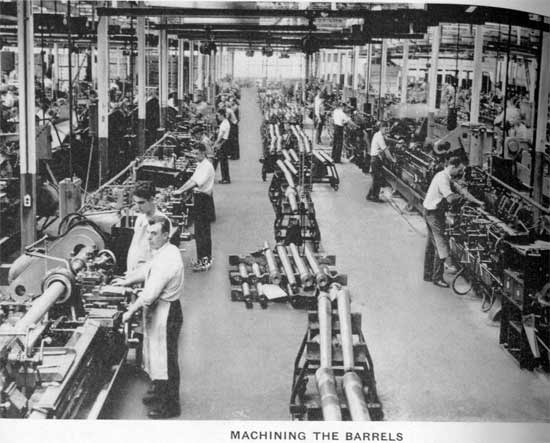 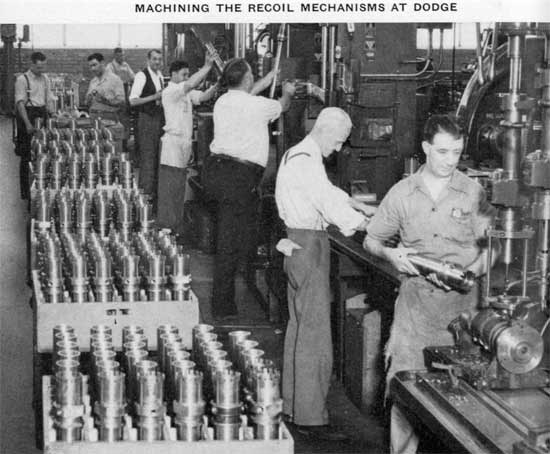 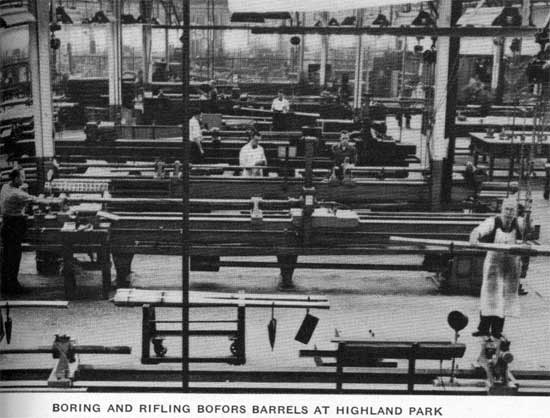 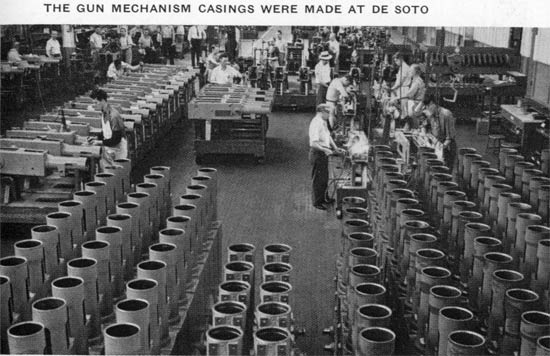 | ||||||||||||||||||||||||
Mikem Member Username: Mikem Post Number: 1379 Registered: 10-2003 Posted From: 68.43.12.165 |
Rocket shell manufacture at Chrysler Kercheval, Dodge Main, and HP: 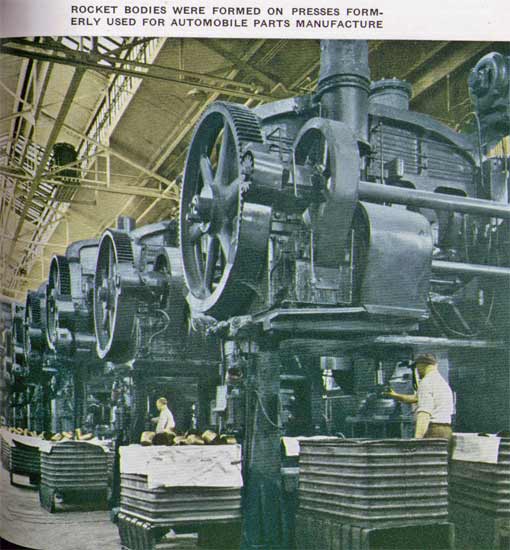 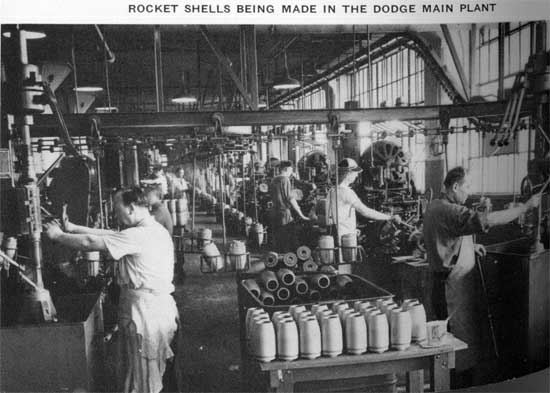 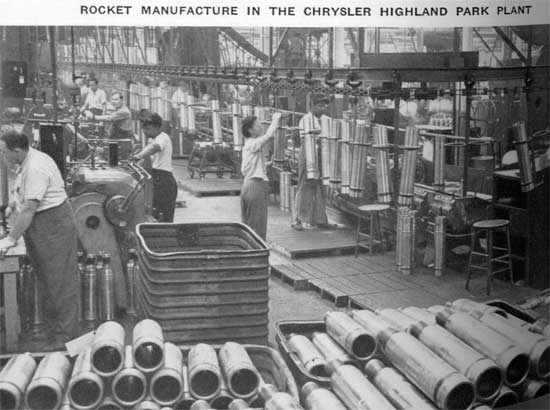 | ||||||||||||||||||||||||
Jjaba Member Username: Jjaba Post Number: 1632 Registered: 11-2003 Posted From: 24.22.6.155 |
Wonderful recollection of WWII. With War now, what war products are currently FOB Detroit for the war effort? We know that they are running 3 shifts at the Hum-vee plant down in Indiana somewhere. jjaba | ||||||||||||||||||||||||
Mikem Member Username: Mikem Post Number: 1380 Registered: 10-2003 Posted From: 68.43.12.165 |
What do we need to produce? We lost 10,000 airplanes in WWII just in training accidents. How many have we lost in Iraq/Afghanistan? I once talked to the former head of the FAA who was stationed in Daytona Beach during the war, on submarine patrol. He said there was hardly a night where from his hotel(barracks) window, you wouldn't see a ship burning on the horizon. How many ships have we lost over there? What's changed more - warfare or manufacturing? | ||||||||||||||||||||||||
Aiw Member Username: Aiw Post Number: 3695 Registered: 10-2003 Posted From: 67.71.66.90 |
Intersting Mike... They must have screwed somthing up to be killed off this quick, and before the Depression too and during the boom years... From the Michigan Manufacturer & Financial Record - Feb. 16, 1924: 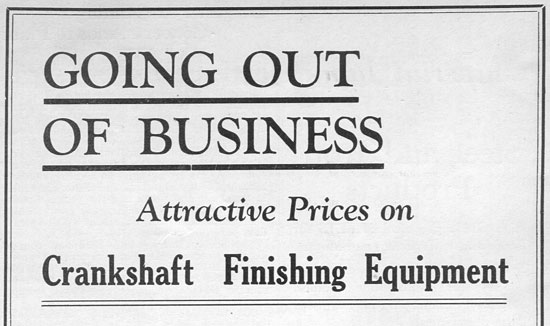 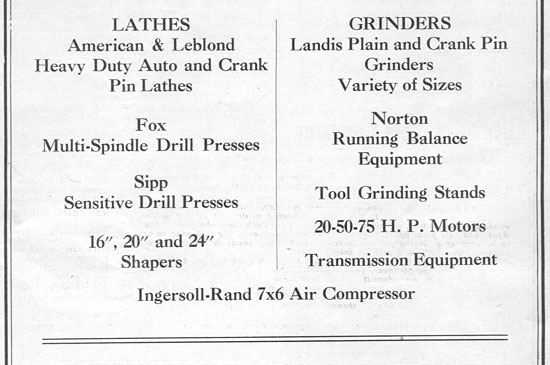 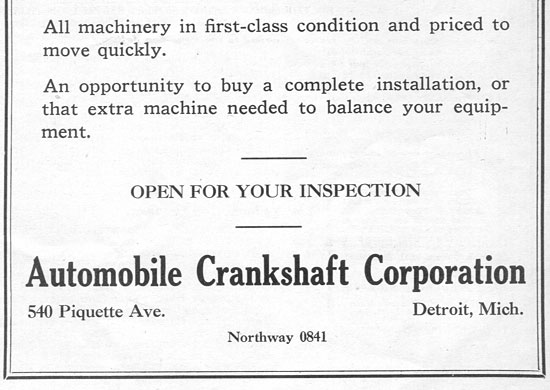 | ||||||||||||||||||||||||
Sven1977 Member Username: Sven1977 Post Number: 66 Registered: 04-2004 Posted From: 209.220.229.254 |
Norton Running Balance Equipment? Remember the Norton building MikeM? | ||||||||||||||||||||||||
Mikem Member Username: Mikem Post Number: 1381 Registered: 10-2003 Posted From: 68.43.12.165 |
There was a post-war depression in '20 or '21, which seemed to thin out quite a few manufacturers. What do you think the effect of WWI government contracts had on the ability of smaller firms to compete? Were firms like Ford, Lincoln, and Packard with their Liberty motor contracts able to modernize and expand, leaving smaller firms at a disadvantage? Did it cause a wave of consolidation in the industry? Yes, I remember the Norton building. In the meantime I've found that one of Henry Leland's early partners was a Charles Norton, another Yankee machinist of the same stripe as Leland and Flanders. He left the partnership of Leland, Faulconer, & Norton early, and I thought he returned back east, so I don't feel confident making a connection between he and the building bearing his name. But then, he was in the crankshaft grinding business... From: http://100megsfree4.com/cadill ac/cad1900/cad03s.htm "Henry Martyn Leland was born to Quaker parents in Vermont in 1843 and learned precision with Samuel Colt in Connecticut and with Brown and Sharpe, makers of tools and machinery in Rhode Island, for whom he developed a hair clipper that made a barber's work considerably easier for years afterward. "In 1890 he took his family and his talents to Detroit, where fine machining was virtually unknown and where he joined up with wealthy lumberman Robert C. Faulconer and tool designer Charles H. Norton in the formation of Leland, Faulconer and Norton. In 1894 Norton left the firm to begin his own enterprise and became a successful manufacturer of crankshaft grinders. Initially, Leland and Faulconer specialized in making precision gears. By 1896 the firm manufactured steam engines for Detroit streetcars and gasoline engines for marine use." Also: http://www.americanprecision.o rg/HFNorton.html | ||||||||||||||||||||||||
Jjaba Member Username: Jjaba Post Number: 1633 Registered: 11-2003 Posted From: 24.22.6.155 |
Excellent history here. This thread is amazing for all we learn. Merci. jjaba, Westsider. | ||||||||||||||||||||||||
Mikem Member Username: Mikem Post Number: 1382 Registered: 10-2003 Posted From: 68.43.12.165 |
For AIW and Sven, here's the scoop on the address re-numbering: An Explanation of the Re-numbering Plan THE PRESENT PLAN: Under the existing plan, which has been discarded by most of the larger cities of the country, there is little, if any, relation existing between the numbers on parallel streets, even in the same neighborhood. For example, "907" Woodward Avenue is at the N.W. corner of Forest, while John R. Street, but one block distant and extending in the same general direction is numbered "691" at the corner of Forest. Similar instances prevail throughout the city. In many instances half numbers only can be assigned to entrances to flats, stores, and upstairs entrances above stores for the reason that only one full number is allowed for each twenty feet. of frontage, and it frequently happens that more than one entrance occurs within this twenty foot limit. Tenants and owners alike strenuously object to the enforced use of the half numbers. Under the new plan, both of these conditions mentioned above are avoided. THE NEW PLAN Under the new plan, all streets extending in the same general direction will be numbered alike at the intersection of the same cross street, and consequently, if the location of a number is known on any street, the location of a like number on any other street extending in the same direction will also be known. For example: Bagg Street will be numbered 1900 at the N.W. corner of Twelfth Street, and every other street extending westerly and crossing Twelfth will be numbered 1900 at the N.W. corner of Twelfth Street. Another point: All streets extending in the same general direction, no matter where they may start, will be numbered as if they did start at a common Base Line. A separate number is allowed for each ten feet of frontage on each side of all streets, instead of twenty feet now in effect. Thus each entrance can and will be assigned a full number. HOW THE NEW PLAN WAS WORKED OUT BASE LINES. Streets extending North and South will begin being numbered with "One Hundred" at a Base Line approximately at right angle with and at the foot of Woodward Avenue. This Base Line extends easterly through Essex Avenue, and westerly follows the line of the Wabash Railroad. The numbers will increase in both directions from this Base Line, and the few streets extending south of this Base Line in the Eastern and Western parts of the city will bear the prefix "South". Streets extending East and West will begin numbering with "One" at a Base Line extending through Woodward Avenue from the Detroit River to the Six Mile Road; and through John R. Street from the Six Mile Road to the City Limits. It is necessary to transfer this Base Line from Woodward Avenue to John R. Street north of the Six Mile Road for the very good reason that above the Six Mile Road there are not streets that start from or cross Woodward Avenue at right angles, and there are no streets that extend north of the Six Mile Road parallel with Woodward Avenue, while this reason does not exist with regard to John R. Street, in this locality. Streets extending from this Base line in both directions under the same name will bear the prefix "East" or "West". NUMBERS ALLOWED EACH BLOCK ETC. Units of one hundred numbers are allowed each city block, as nearly as practical, but where a city block exceeds five hundred feet in length an additional unit of one hundred numbers is allowed. Unused numbers in a unit will be dropped at the end of each block. To rectify or even up the numbers at intersecting streets to correspond with the numbers on parallel streets, not only the unused numbers in a unit will be dropped, but also the unused units will be dropped at the end of blocks where necessary. EVEN AND ODD NUMBERS. Even and Odd Numbers will be assigned to streets in the same manner as under the old plan; the even numbers on the right hand side and the odd numbers on the left, facing out from the Base Lines. THE LAYOUT OF THE CITY. By glancing at a Detroit City Map it will be found that many streets extending in the same general direction are not exactly parallel, that many streets do not extend through with adjoining streets, and also that many city blocks vary greatly in length. On account of these conditions, to maintain the same numbers in relative blocks in streets extending the same general direction, it becomes necessary to drop not only unused numbers in a unit, but unused units as well. This condition prevails in Cleveland and in other cities numbered on the new Detroit plan. For example: in the down town district, it is six blocks from Woodward to Second on Fort Street West, and the number "600" is assigned to the N.W. corner of Fort Street at Second. North of the Boulevard, due to the fact that intervening streets do not extend through, and also the fact that Second slants toward Woodward, it is but one city block of about 565 feet from Woodward Avenue to Second. Yet to maintain the uniform "600" at the N.W. corner of all streets crossing Second Avenue, all unused numbers and units of numbers below "600" are dropped at the end of the block and the next block from Second to Third begins with the number "600" at the N.W. corner of Second. It is reasonable to expect that adverse criticism will be heard in regard to the new plan from time to time, but it is firmly believed that when the new plan has been in operation a short time it will merit the confidence and approval of the public, as has been the case in all the larger cities where it has been put in effect. It should be remembered that: 1. The new numbers must not be used before January 1, 1921. 2. The old numbers must not be used after January 1, 1921. 3. The old numbers should not be removed before March 1, 1921. DEPARTMENT OF PUBLIC WORKS Joseph A. Martin Commissioner | ||||||||||||||||||||||||
Jjaba Member Username: Jjaba Post Number: 1635 Registered: 11-2003 Posted From: 24.22.6.155 |
Friends from Chicago get very confused by Detroit's numbering system. Now jjaba can explain how W. Grand Blvd. and Rosa Parks (12th St.) is not 1200 W. Grand Blvd. It is because the numbered streets don't parallel Woodward Avenue exactly. Ofcourse, we all know that North of Mc Nichols, Woodward is so angular that John R is the E/W divide. Having said that, jjaba still is too 'ascared to risk going over there. Traditions are hard as hell to overcome. Besides, what's over there anyways! jjaba, Westsider. | ||||||||||||||||||||||||
Jjaba Member Username: Jjaba Post Number: 1636 Registered: 11-2003 Posted From: 24.22.6.155 |
It should also be noted that some suburbs use a continuation of Detroit's numbers while others start with their own schemes. Some suburbs also use the Detroit zip codes such as Highland Park, Hamtramck, Oak Park, and Ferndale. Even the Grosse Pointes use Detroit zip codes. Crazy, eh. jjaba | ||||||||||||||||||||||||
Hornwrecker Member Username: Hornwrecker Post Number: 7 Registered: 04-2005 Posted From: 67.192.64.213 |
Has Divco been covered yet? I remember that they made milk trucks at a plant at Eight Mile and Hoover area. I think that the building is still there, but I'll have to drive around and check tomorrow. http://www.divco.org/divco%20h istory.htm As to the numbering; what happens if your house is on a curve on Outer Drive? Try explaining Outer Drive to someone from out of town sometime, yikes. Norton Emery Wheels was the name of the old company, which is now just Norton. They still are one of the largest makers of grinding wheels in the world, something that I think are used a lot in Detroit. | ||||||||||||||||||||||||
Mikem Member Username: Mikem Post Number: 1384 Registered: 10-2003 Posted From: 68.43.12.165 |
I don't think Divco was in Detroit...Warren maybe? I'd love to turn my car in for a Divco. A friend in college had a Divco diaper delivery truck with no driver's seat. Nothing like driving standing up! His sliding door wouldn't close either. Not sure how that was legal. Two sofas, a stereo, and a purple light in back made for fun times. | ||||||||||||||||||||||||
Hornwrecker Member Username: Hornwrecker Post Number: 9 Registered: 04-2005 Posted From: 67.192.64.213 |
I don't think Divco was in Detroit...Warren maybe? The list from the web site has the various name iterations of Divco. Maybe the Continental connection could provide some clues, or maybe something with the Detroit Electric Car Co. ??? 1) Detroit Industrial Vehicle Co., Detroit, Mich. 1926-1927 (2) Divco-Detroit Corp., Detroit, Mich. 1927-1934 (3) Continental-Divco Co., Detroit, Mich. 1934-1935 (4) Divco-Twin Truck Co., Detroit, Mich. 1936-1944 (5) Divco Corp., Detroit, Mich. 1944-1956 (6) Divco Truck Div., Divco-Wayne Corp., Detroit, Mich. 1957-1967 A friend was over today and we looked at this thread; one question he had after looking a some of the Sanborn maps is that there seemed to be large lumber yards located near the auto plants. One suggestion that I had was that maybe they needed a lot of wood for coach construction. Does anyone else remember lumberyards in a lot of areas in Detroit. There used to be a lot in the Nortown area when I was growing up. Also: I've been trying to find some info on the Detroit Terminal Railroad {main yards and roundhouse at Mound and Davison}, but haven't been having much luck online. Does anybody have any books, sources, or websites to reccomend? | ||||||||||||||||||||||||
Mikem Member Username: Mikem Post Number: 1386 Registered: 10-2003 Posted From: 68.43.12.165 |
I've asked here before about Divco, but no one seems to know. I have the feeling it's right under our noses somewhere. I said Warren earlier, not because you mentioned 8 & Hoover, but because I've heard that somewhere else. This building is on Piquette across from Studebaker, but I think Kathleen told me once that it was some other company: 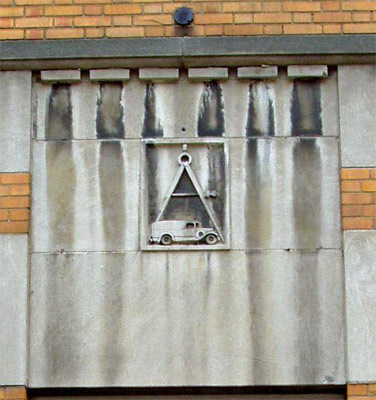 I've noticed all the lumber yards as well. I have a suspicion they existed due to the huge home and commercial building boom going at the time those maps were published, i.e., 1900-1930. Now you find Wicks out in Lake Orion or Clarkston instead of Mack & St Jean. I love that North Detroit area; I easily get a feel for the old days driving through there. I can't find squat on the DTRR either. Was it a joint ownership or subsidiary of other railroads? Make a new thread asking the question...it might get an answer. Douglasm is a poster who stops in once and a while, and is very knowledgeable about the railroad history of the area. | ||||||||||||||||||||||||
Mikem Member Username: Mikem Post Number: 1387 Registered: 10-2003 Posted From: 68.43.12.165 |
AIW, I found an address for your B&W picture of the National Production Co back on page 4: 2999 Bellevue, north of Charlevoix. I'll look again this week. Also on page 4: American Blower Co was at 6004 Conant, corner of Harper. On page 5 you had the Gear Grinding Co: Conant at the Grand Trunk RR. | ||||||||||||||||||||||||
623kraw Member Username: 623kraw Post Number: 600 Registered: 10-2003 Posted From: 68.41.224.200 |
6004 Conant, corner of Harper no longer exists today. It was wiped out by GM Poletown and I-94. Conant now merges into Mt. Elliot. | ||||||||||||||||||||||||
Kathleen Member Username: Kathleen Post Number: 431 Registered: 10-2003 Posted From: 69.14.122.57 |
MikeM: The building on Piquette opposite the Studebaker plant was an AutoCar truck dealership. Some AutoCar history: http://www.autocartrucks.com/h istory.asp | ||||||||||||||||||||||||
Hamtramck_steve Member Username: Hamtramck_steve Post Number: 2030 Registered: 10-2003 Posted From: 68.41.218.4 |
Conant merged into Mt. Elliott long before the creation of GM's Poletown Plant. The only possible explanation for a location of "Conant & Harper" is that somebody made a mistake. | ||||||||||||||||||||||||
Hornwrecker Member Username: Hornwrecker Post Number: 10 Registered: 04-2005 Posted From: 67.192.63.225 |
While googling for Divco info, I found this DetNews article on the first trucks made in Detroit, http://info.detnews.com/joyrid es/story/index.cfm?id=122 Grabowsky Motor Vehicle Co. was in Detroit from 1902 until 1906 when they moved to Pontiac. In 1904 they changed the name to Rapid. I used to live next door to a Twin Pines milkman, so I have fond memories of his green and cream yellow Divco. It was also handy, as it saved many trips to the store. Back then all you had to do was take what you needed from the truck, write it down, and leave some change. | ||||||||||||||||||||||||
Mikem Member Username: Mikem Post Number: 1388 Registered: 10-2003 Posted From: 68.43.12.165 |
Oops, my mistake....American Blower Co: 6004 Russell, corner of Harper. | ||||||||||||||||||||||||
| Discuss Detroit » Hall of Fame Threads » Old Car Factories » Old Car Factories - 7 |
|